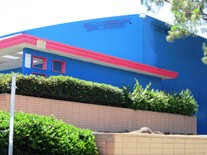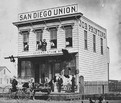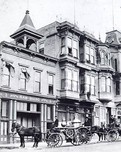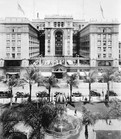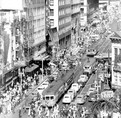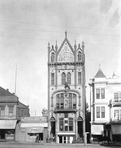
Will C. Crawford HS - Alumni Association & Foundation

Downtown San Diego
Please enjoy these photographs of early Downtown San Diego.
A Brief History:
The city of San Diego was originally focused in Old Town near the Presidio, several miles north of current Downtown. The location was not ideal because it was several miles from navigable water. In 1849 Lt. Andrew B. Gray, a surveyor working with the boundary commission to establish the boundaries of the new state of California, suggested that an area closer to San Diego Bay would be a better location for a city because it would be better for trade. He proposed the idea to William Heath Davis, who recruited four other investors. The partners under Davis's leadership purchased 160 acres of land in what is now Downtown San Diego. They laid out a street plan for New Town and built a wharf and warehouse. Several people built houses there, including the still-standing William Heath Davis House, now a museum. However, New Town did not do well due to a lack of fresh water, a financial depression in 1851, and opposition from the established settlements in Old Town and La Playa.
In 1867 Alonzo Horton purchased 800 acres of pueblo lands in the current Downtown area, and in 1869 he added Davis’s 160 acres to his holdings; the area was referred to as the Horton Addition. Davis’s wharf had fallen to pieces by then, but Horton realized the area was still ideal for a harbor. He built a new wharf at the end of Fifth Avenue in 1869. He vigorously sold property and gave away land to promote development of the area, fueling the first of San Diego’s many real estate speculation booms. People flocked to the area, known as New Town, because of its better access to shipping.
In 1871 government records were moved to a new county courthouse in New Town. By the 1880s New Town had totally eclipsed Old Town (as it is called to this day) as the heart of the growing city.
In 1885 the transcontinental railroad reached San Diego. The Santa Fe railway station opened downtown in 1887. (That station was replaced in 1915 by the Downtown landmark Union Station which is still in use.) In 1886 the city’s first electric lights and first streetcars were established in New Town. In 1912 the Spreckels Theater opened downtown, the first modern commercial playhouse west of the Mississippi. A new commercial pier, the Broadway Pier, was built by the city in 1913.
In the 1910s, Downtown became one of the many San Diego neighborhoods connected by the Class 1 streetcars and an extensive San Diego public transit system that was spurred by the Panama-California Exposition of 1915 and built by John D. Spreckels. These streetcars became a fixture of the neighborhood until their retirement in 1939.
In 1964 the multi-story City Hall and Community Concourse were dedicated on a four-block-square property at 202 'C' Street. Recent mayors and city councils have discussed building a replacement city hall, but no replacement plan has been approved.
In the 1960s, Centre City began to fall into a state of disrepair and disrepute. Major businesses and stores moved from downtown to suburban shopping malls. Downtown became known as a hangout for homeless people and sailors on liberty. Tattoo parlors, bars, and strip clubs were predominant forms of business. Trash littered the Gaslamp Quarter, many 19th century Victorian houses were rundown, and there were few buildings of significant size (the tallest building at the time was fourteen stories, the locally famous El Cortez Apartment Hotel). Despite this, low and mid-rise buildings were beginning construction.
In 1975, redevelopment plans were created for Downtown. In 1985, Downtown underwent more redevelopment with the completion of Horton Plaza, the Gaslamp Quarter revival, and the completion of the San Diego Convention Center. Petco Park, a baseball ballpark used by the San Diego Padres, opened in 2004.
Links:
Gaslamp District & Downtown Historic Structures

